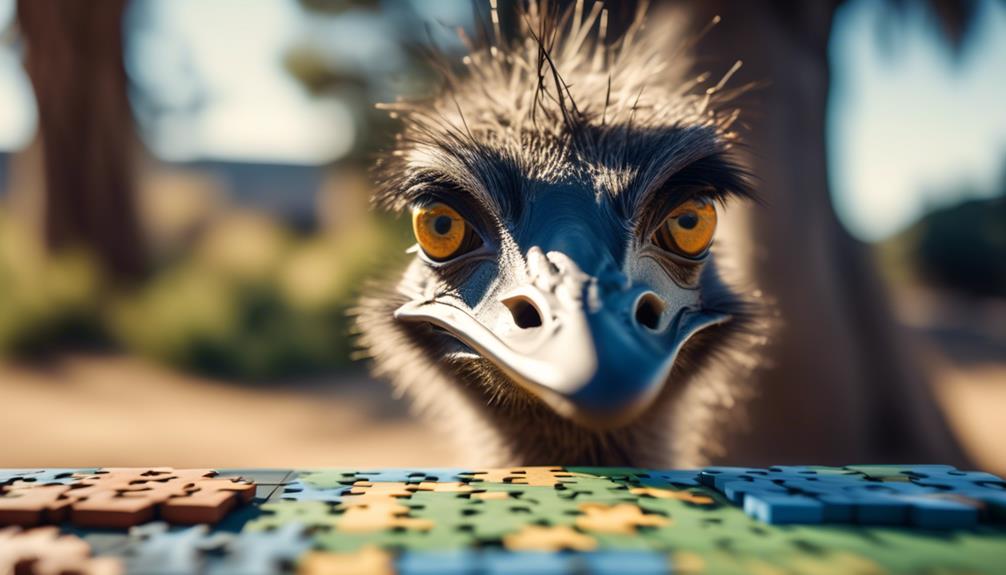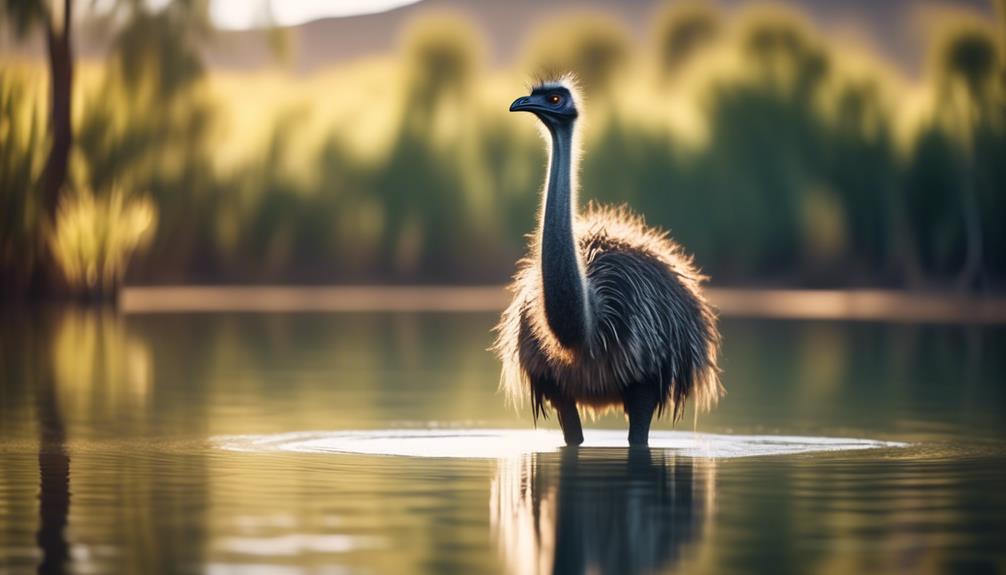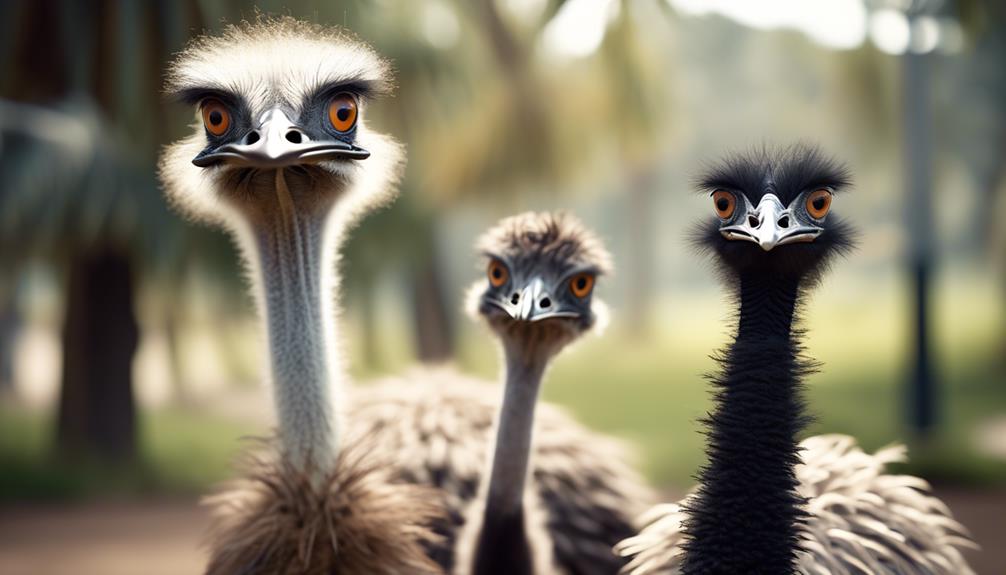
Have you ever heard the expression 'like an emu with its head in the sand'? It's often used to describe someone who is willfully ignorant or oblivious to the truth.
But what if I told you that this popular saying is based on a myth about emus? In fact, there are many misconceptions surrounding these fascinating creatures.
In this discussion, we will separate fact from fiction and shed light on the truth about emus. Get ready to challenge your preconceived notions and discover the real story behind these enigmatic birds.
Emus Are Flightless Birds

Emus, as flightless birds, are unable to achieve sustained flight due to their unique anatomical adaptations. However, their inability to fly doesn't diminish their significance in Australian culture. In fact, emus hold a special place in the hearts of Australians as symbols of resilience and adaptability.
Emus have long been admired for their ability to survive in harsh and unpredictable environments. Their strong legs and powerful muscles enable them to run at impressive speeds of up to 30 miles per hour, making them one of the fastest ground-dwelling birds. This exceptional speed allows them to quickly escape from predators and navigate vast distances in search of food and water.
Furthermore, emus have shown remarkable adaptability in the face of changing conditions. They're able to withstand extreme temperatures, from scorching heat to freezing cold, thanks to their thick layer of insulating feathers. Additionally, their ability to consume a wide variety of plant matter, including leaves, fruits, seeds, and even insects, ensures their survival in diverse habitats.
In Australian culture, emus have become symbols of resilience and determination. Their ability to thrive in challenging environments resonates with the Australian spirit of perseverance in the face of adversity. Emus exemplify the notion that one can overcome obstacles and thrive despite being unable to fly. Their presence in the Australian landscape serves as a reminder of the strength and adaptability inherent in nature.
Emus Can't Walk Backwards
As we explore the topic of emus and their unique characteristics, it's important to note that one intriguing fact about these remarkable birds is their inability to walk backwards. Emus, with their distinct physical attributes, are known for their long legs and strong muscles, which enable them to run at high speeds. However, due to the structure of their knee joints and the positioning of their toes, walking backward is simply not possible for these elegant creatures.
Emus' unique physical characteristics contribute to their role in Australian culture. These birds are native to Australia and hold a special place in the hearts of the indigenous people. They're often seen as symbols of strength, resilience, and adaptability. In fact, emus are featured prominently in Aboriginal dreamtime stories, where they're depicted as wise and mystical creatures.
In addition to their cultural significance, emus also play a crucial role in maintaining the balance of Australia's ecosystem. As herbivores, they help control the growth of vegetation by feeding on grass, leaves, buds, and fruits. By doing so, they prevent overgrowth and ensure a healthy environment for other plant and animal species.
While emus may not possess the ability to walk backwards, their unique physical characteristics and cultural significance make them truly fascinating creatures. Their contribution to the ecosystem and their place in Australian culture only further emphasize the importance of understanding and appreciating these majestic birds.
Emus Are Aggressive and Dangerous

Emus' reputation for being aggressive and dangerous is often exaggerated and misunderstood. While it's true that emus can display defensive behaviors when they feel threatened, their overall temperament isn't inherently aggressive. Emus are naturally curious, intelligent, and social animals, which makes them suitable candidates for therapy and as pets.
When properly socialized and raised in a nurturing environment, emus can form strong bonds with humans. They've been observed to exhibit gentle and affectionate behaviors towards their caretakers. In fact, some individuals have successfully trained emus to assist in therapy sessions, providing comfort and companionship to those in need.
As with any animal, it's important to approach emus with caution and respect their boundaries. They've powerful legs and sharp claws, which they may use if they feel threatened or cornered. However, instances of emus causing serious harm to humans are extremely rare and typically occur as a result of mishandling or provocation.
Emus Are Carnivorous Predators
Emus aren't carnivorous predators, but rather herbivorous birds with a diet mainly consisting of plant matter. While emus possess sharp beaks and strong legs, they don't use these attributes to capture prey. Emus' feeding habits are quite different from that of carnivorous predators. In fact, their diet primarily consists of fruits, seeds, flowers, and leaves. They've been observed feeding on a variety of plants, including grasses, shrubs, and even cacti.
As pets, emus can be quite fascinating. Their herbivorous nature makes them relatively easy to care for, as their diet can be met with a well-balanced mix of fruits, vegetables, and grains. Feeding emus a diet rich in nutrients is essential to their overall health and well-being. It's important to provide them with a suitable environment that mimics their natural habitat, allowing them to forage for their food and engage in natural behaviors.
Emus Are Stupid or Unintelligent

Contrary to the misconception that emus are unintelligent, their behavior and problem-solving abilities demonstrate a level of cognitive complexity that challenges the notion of their supposed lack of intelligence.
Emus possess remarkable problem-solving abilities that showcase their adaptability and resourcefulness in their natural environment. They use problem-solving skills to navigate their surroundings, such as finding the most efficient routes to access food and water sources. They're known to remember successful pathways and use them repeatedly, indicating a high level of cognitive ability.
Emus also exhibit social behavior that suggests a level of intelligence. They form complex social hierarchies, with dominant individuals taking charge. Social interactions require communication and understanding of social cues, indicating a level of intelligence and social awareness.
Furthermore, emus have been observed using their problem-solving abilities to overcome obstacles. For example, they've been known to manipulate objects to access food, such as using their beaks to open containers or using their feet to flip over rocks. These actions require both physical dexterity and cognitive flexibility.
Emus' problem-solving abilities and social behavior demonstrate a level of intelligence that's often underestimated. Their ability to navigate their environment and adapt to different situations highlights their cognitive complexity and challenges the misconception of their supposed lack of intelligence.
Emus Have Weak and Useless Wings
The wings of emus, while not capable of flight, serve important functions in their overall anatomy and lifestyle. Although they may appear weak and useless, emus' wings are actually well-adapted to their unique needs. Let's take a closer look at the anatomy and functionality of these fascinating appendages.
| Emus' Wing Anatomy | Emus' Wing Functionality |
|---|---|
| Feathers | Emus' wings are covered in a thick layer of feathers, which provide insulation, protection, and aid in communication. Feathers also play a role in courtship displays, where males fan their wings to attract females. |
| Muscles | Despite their inability to fly, emus' wing muscles are well-developed. These muscles allow emus to control their wing movements and assist in balance and stability while running. |
| Bones | Emus' wings contain bones that are modified for strength rather than flight. The bones are sturdy and serve as support structures for the muscles and feathers. |
| Vestigial Claws | Emus' wings possess small, vestigial claws at the end. While these claws are not used for flying, they can be handy tools for defense and grooming. |
Emus Can't Swim

Despite their well-developed wing muscles and sturdy wing bones, emus have a notable limitation when it comes to water – they're unable to swim. While emus are known for their ability to run at high speeds and navigate through challenging terrains, their lack of swimming skills hampers their survival in aquatic environments.
Here are three reasons why emus struggle in water:
- Body structure: Emus have a large, heavy body that isn't conducive to buoyancy. Their long legs and necks, while advantageous on land, make it difficult for them to stay afloat in water. Additionally, their short, stubby wings aren't designed for propulsion in aquatic environments.
- Feathers and oil glands: Emus possess fluffy, loose feathers that trap air and aid in insulation. However, these feathers become waterlogged when submerged, making it even more challenging for them to stay afloat. Unlike aquatic birds, emus lack the oil glands necessary to waterproof their feathers, further hindering their ability to survive in water.
- Predator vulnerability: In addition to their physical limitations, emus' inability to swim makes them vulnerable to predators in aquatic habitats. Without the ability to flee or seek refuge in water, emus become easy targets for predators such as crocodiles and large fish.
Understanding these limitations is crucial when considering the survival strategies of emus. While they excel on land, their inability to swim restricts their access to water sources and increases their vulnerability to predation.
Emus Have a High Population in Australia
Emus in Australia have thrived and established a significant population. These majestic flightless birds are an essential part of the Australian ecosystem, and their presence is deeply ingrained in the country's culture. With their remarkable adaptability and resilience, emus have managed to thrive in a range of habitats, from the arid outback to the coastal areas.
Emus play a vital role in maintaining the balance of the ecosystem. As herbivores, they consume a variety of plants, including seeds, fruits, and leaves. This grazing behavior helps to control vegetation growth and prevent the dominance of certain plant species. Additionally, emus act as seed dispersers, aiding in the regeneration of plant communities.
In Australian culture, emus hold a special place. They're depicted in various forms of art, from Aboriginal paintings to contemporary sculptures. Emus have also been adopted as national symbols, representing the unique wildlife and natural heritage of Australia.
Despite their high population, emus face several challenges, including habitat loss and fragmentation. As human activities continue to encroach upon their habitats, it's crucial to implement conservation measures to ensure the long-term survival of these remarkable birds.
Emus Are the Same as Ostriches

As we shift our focus to the subtopic of 'Emus Are the Same as Ostriches,' it's important to compare and contrast these two remarkable flightless birds found in different parts of the world.
- Emus and ostriches: Although emus and ostriches share certain similarities, they're distinct species with notable differences in appearance, habitat, and behavior.
- Appearance: Emus and ostriches may both be large, flightless birds, but their physical characteristics set them apart. Emus have a brownish-gray plumage, while ostriches flaunt a black and white plumage. Additionally, emus possess a distinct crown of feathers on their head, while ostriches have a distinctive long neck and small head.
- Habitat: Emus are native to Australia, where they inhabit various habitats such as grasslands, forests, and deserts. On the other hand, ostriches are found in parts of Africa, primarily in savannas and arid regions.
- Indigenous culture: Emus hold significant cultural importance in indigenous Australian culture. They're revered for their spiritual symbolism and are often depicted in traditional artworks and stories. Ostriches, however, don't hold the same cultural significance in indigenous African cultures.
Understanding the distinctions between emus and ostriches allows us to appreciate the unique qualities of each species and the role they play in their respective habitats and cultures.
Frequently Asked Questions
How Many Species of Emus Are There?
There are two species of emus: the common emu and the dwarf emu. Emu conservation efforts aim to protect their habitat and promote sustainable practices. Emu breeding programs play a vital role in ensuring the survival of these magnificent birds.
Can Emus Be Found in Any Other Countries Besides Australia?
Yes, emus can be found in other countries besides Australia. Emus in captivity can be found in various parts of the world, while in some cases, they have become an invasive species.
Do Emus Have Any Natural Predators?
Emus in the wild: Are they vulnerable to any predators, or are they at the top of the food chain? How do they defend themselves? Emus are not at the top of the food chain and have natural predators such as dingoes and eagles. They defend themselves by running away or using their powerful legs to kick.
How Long Do Emus Typically Live in the Wild?
In the wild, emus typically live for an average of 10-20 years. Their lifespan can be affected by various factors such as predation, disease, food availability, and environmental conditions.
Are Emus Kept as Pets in Some Parts of the World?
Yes, emus are kept as pets in some parts of the world. They can also be used as therapy animals for emotional support. However, they can become agricultural pests, damaging crops and causing problems for farmers.
Conclusion
In conclusion, it's important to separate fact from fiction when it comes to emus.
Contrary to popular belief, emus aren't aggressive or dangerous, nor are they carnivorous predators. They're intelligent birds with strong, useful wings that can swim if necessary.
Interestingly, the emu population in Australia isn't as high as commonly thought, with an estimated 700,000 emus remaining.
These fascinating flightless birds deserve our respect and understanding.




